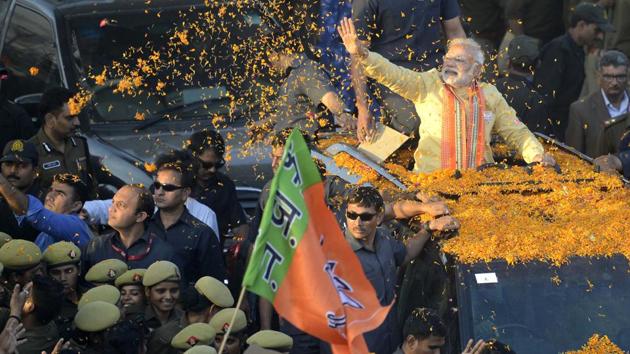UP election results: Caste calculus, note ban and Hindutva behind BJP landslide
Road shows are not more than a show unless backed by consistent work on the ground. Here the Sangh Parivar was far ahead.
The BJP’s landslide victory in the Uttar Pradesh assembly elections is, apart from PM Narendra Modi’s connect with the voters, a combined harvest of social engineering, creative spin to demonetisation as anti-rich with substantial benefits to come, and a polarisation strategy based on the tested Hindutva card, political analysts said.

Of the 403 seats, the BJP bagged 312 (+265), Samajwadi Party 47 (-177), BSP 19 (-61) and the Congress 7 (-21). “This could not have happened without the Sangh Parivar’s sustained campaign on the ground since 2014,” said professor Kamal Mitra Chenoy of JNU. Under the social engineering strategy, the BJP won over non-Yadav OBCs and made inroads into non-Jatav dalits while consolidating upper castes, especially the Brahmins, he said. Yadavs are the core vote base of the SP and Jatavs of Mayawati’s BSP.
The BJP had woken up to the electoral importance of backward castes and dalits after it lost both UP and Madhya Pradesh in 1993 polls despite its attempts to consolidate Hindu votes under the Ram Janmabhoomi movement. The SP-BSP victory in UP proved the potency of caste over religion in elections. In 1990, then Prime Minister VP Singh’s implementation of the Mandal commission report, which provided 27% reservation to OBCs, spurred consciousness among backward and lower castes, and they became assertive for political representation.
Faced with the challenge of mandalisation of politics, the BJP started promoting low-caste people in the party apparatus. Uma Bharti, a Lodh who became the chief of the BJP’s youth wing in 1994, had said, “We should change the image of the party…We have to go to the grassroots, to the dalits. The party has become complacent after the Ram Janmabhoomi movement. Kanshi Ram has woken us up.”
KN Govindacharya was the main advocate of the inclusion of low-caste members at all levels of the party organization. He called this policy social engineering that reflected electoral pragmatism and led to dilution of the saffron party’s core ideological doctrine – forging Hindu unity through sanskritisation (emulation of the high-caste culture). The BJP stopped questioning reservation, and became open to more quota for assertive castes.
Ahead of the Uttar Pradesh polls, the BJP reached out to the poor by projecting demonetisation – recall of high-value notes on November 8 last year – as an attack on the affluent and their big money hoards. Chenoy said, “Note ban was portrayed as a temporary problem leading to more cash support later.”
Prof Arun Patnaik of Hyderabad University said, “The UP mandate is both a vote against incumbency and a vote with hope for demonetisation gains. People are hopeful of positive fallout of the note ban on their Jan Dhan accounts despite their sufferings. They expect positive outcome in the next six months. That’s a major reason behind this massive mandate.”
The demonetistion move has not met its main objective – checking black money and counterfeit currency – as most of the notes banned have returned to the banking system.
The BJP and its allied outfits also harped on Hindutva – positing Hindus against the Other – to bolster their poll prospects. Bulding a Ram temple was included in the manifesto, and Modi spoke the language of ‘smashan-kabarstan’ during the campaign.
“The polarisation strategy that the RSS has honed over decades was successful, raising questions about the Election Commission’s capacity to curb divisive propaganda,” Chenoy said. “This election shows simple caste arithmetic is insufficient. The SP-Congress alliance and the BSP failed to give enough attention to class, gender, regional and economic issues.”
Road shows are not more than a show unless backed by consistent work on the ground. Here the Sangh Parivar was far ahead.





